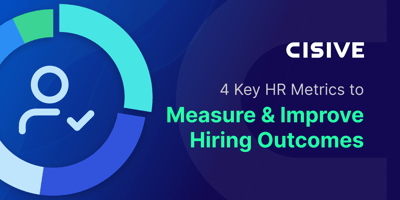

Without data, how will you ever really know whether your efforts are working? How can you...

Recruiting is a lot of work, but it’s one of the best kinds of work. When you’re recruiting, it means you’re working for a growing company. But measuring success in hiring can be challenging, especially if you’re not tracking the correct data up front.
Avoid the potential for improper decision-making or operational inefficiencies by identifying the ideal recruiting metrics that will help you gauge the success of your efforts. In this article, we’ll outline 13 of the most important hiring metrics for you to consider in your recruitment process.
Key TakeawaysHere are the key things you need to know about hiring metrics:
|
Hiring metrics are also called staffing metrics or recruiting metrics. They track data points an HR team can use to measure and optimize their hiring process.
At their core, hiring metrics give you a basis for evaluating your entire recruiting process. You’ll gain insights into whether your hiring strategies are working and when things aren’t working so well. You’ll also be able to make informed adjustments to your hiring practices to make sure you’re hiring the right talent.
Plus, the data can eventually save the company money by reducing recruitment costs and helping ensure they’re hiring employees who stay longer.
Here are 13 of the top recruiting metrics and how you can calculate them. It’s not likely that you’ll need or want to track all of these. Pick the ones that make sense for you.
This measures the length of the recruitment period for a given job posting. It’s usually measured by the number of days from the date the job was posted to the day a candidate is hired. It gives your business stakeholders a realistic view of how long it will take to locate and hire a qualified candidate for a position.
Tracking your time-to-fill metric also helps HR teams and managers optimize hiring strategies. For example, a long time-to-fill average could be a sign of ineffective recruiting tactics that could be improved.
Time to hire is different from time to fill. Time to hire is measured by the number of days from when the candidate applies for the job to the day they accept your offer. This metric is sometimes called time to accept.
Time to hire varies by role. For example, hiring a C-Suite executive usually takes longer than hiring a junior person. But, in general, for all roles, the goal is to reduce your time to hire. You want candidates to be able to move forward efficiently in order to avoid losing them to other companies.
Like time to fill, tracking time to hire helps pinpoint inefficiencies in the hiring process.
The selection ratio is the number of hired candidates versus the total number of candidates. To calculate the selection ratio, simply divide the number of hired candidates by the number of total candidates.
For example, if your marketing manager job attracted 25 applicants and you hired one, your selection ratio is 1/25. If a cashier job attracted 100 applicants and you hired three of them, your selection ratio is 3/100. This ratio can help you assess the effectiveness of the recruitment tools you’re using.
The cost per hire is the amount you spend on recruitment divided by the total number of people you hire. This is usually measured per year.
More specifically, cost per hire is internal costs plus external costs, divided by the number of total hires. External costs include the amount you spend on advertising, background checks, and paying for candidates to travel for interviews.
Internal costs include time spent by the recruiter and hiring manager, time spent onboarding a new hire, and administrative costs. If your cost per hire is identified as being too high, targeted adjustments can be made in your hiring process.
This metric is the percentage of employees who leave the company within 12 months or fewer of being hired. First-year attrition matters because it costs a lot of money to hire, onboard, and train someone. When they leave so quickly, the company never recoups that investment.
To calculate, take the number of new hires who left in the last 12 months and divide it by the total number of new hires in the last 12 months. For example, if you hired 50 people and 10 of them left, your attrition rate is 10 divided by 50. That’s a 20% attrition rate.
If new hire attrition is high, you may want to revisit your job descriptions and onboarding practices. Also, investigate whether hiring managers are communicating honestly with candidates during the hiring process. A high attrition rate can also mean that your corporate culture is not sufficiently welcoming of new people.
This measures the performance of a new hire in their first year on the job. Performance is not always easy to measure, but it’s important. If new hires don’t perform well, it doesn’t matter how quickly you fill roles or how much you control recruiting costs.
Calculating the quality of a hire differs from company to company. Work with your leadership team to create a definition of a quality hire.
You could come up with a system that scores employees from 1 to 100. You could score based on things like ramp-up time, specific aspects of job performance, cultural fit, and the level of engagement they’ve demonstrated. Then, decide what total score would indicate that you’ve made a quality hire.
This metric measures how many potential candidates each recruitment channel is bringing in. It allows you to see which channels are providing successful candidates and which are not. If you understand which channels are underperforming, you can either invest in improving those channels or you can eliminate them.
Maybe a certain job board led to 50 applications, while a different job board led to only three applications. You could then decide to stop spending money posting on the less effective board.
This is a measure of the effectiveness of your recruitment outreach phone calls. To calculate, take the number of candidates who returned your phone call divided by the total number of calls you placed. Say you called 20 candidates and asked them to call you back, and eight of them did. Your candidate call-back rate is eight divided by 20, or 40%.
Knowing your candidate call-back rate helps you assess the effectiveness of your recruiting pitches. If the rate is low, perhaps you can revise your recruiting pitch.
To calculate the acceptance rate, divide the number of accepted offers by the number of offers made. A low acceptance rate can illuminate problems that should have been clarified earlier in the hiring process.
Low acceptance rates can indicate that candidates are not impressed by aspects of your offer. It could be the compensation, benefits, flexibility of work arrangements, or something else.
You could improve acceptance rates by adjusting your recruitment practices. For example, posting the salary in your job descriptions lets applicants know the compensation range. This prevents people from applying and later dropping out when they find out the salary is lower than they’d anticipated.
This is the percentage of new hires who successfully finish all required onboarding tasks and training in the assigned time frame. Onboarding tasks vary by company but can include policy acknowledgements, compliance classes, system training, and more.
You calculate this metric by dividing the number of new hires who completed all required tasks by the total number of new hires. If 20 out of 40 new hires completed all tasks, your completion rate is 50%. The higher the rate, the better your onboarding process.
You can conduct a survey of job applicants to measure the candidate experience. A survey using Net Promoter Score (NPS) can help you identify ways to improve your recruitment and hiring. It’s a good idea to survey both the people you hire and the people you don’t hire.
Use Equal Employment Opportunity (EEO) dashboards, candidate surveys, hiring feedback, and other data to gauge how well you’re doing in hiring diverse candidates. Your data could uncover barriers to recruiting candidates of color, women, or other marginalized groups. If diversity in recruitment numbers is high but hiring percentages are not, you can address this issue with your hiring managers.
This is a gauge of how pleased the hiring manager was with the candidates you recruited. You could measure this through a satisfaction survey. To obtain this metric, you ask the manager to rate different parts of the process on a 1-to-100 scale. The higher the score, the better.
Once you know which hiring metrics you want to track, how will you do it? Manual methods can be far too time-intensive. Consider Cisive’s human capital management solution and analytics reporting tool instead. Our easy-to-use technologies help you track the metrics you care about most in real time so you can get actionable insights quickly.
Measuring recruitment efforts can save money and increase job satisfaction for managers and new hires. Cisive offers the HCM and analytics tools to help you track hiring metrics successfully. Speak with a Cisive expert to learn more.

Without data, how will you ever really know whether your efforts are working? How can you...

Comprehensive background checks can alert employers to potential issues with prospective...

Job candidates touting fake diplomas and fraudulent credentials pose significant risks to business...